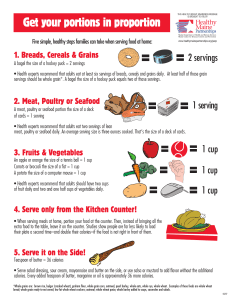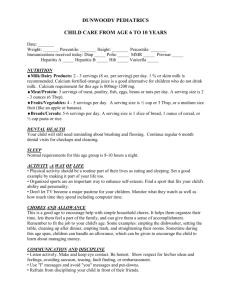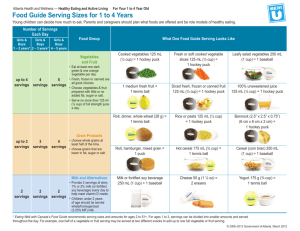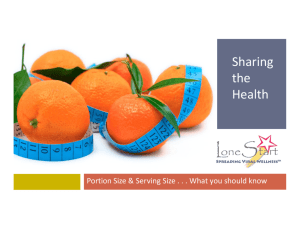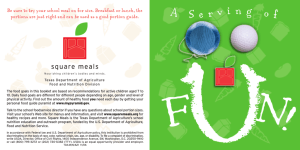Nutrition Placemat Teaching Manual
advertisement
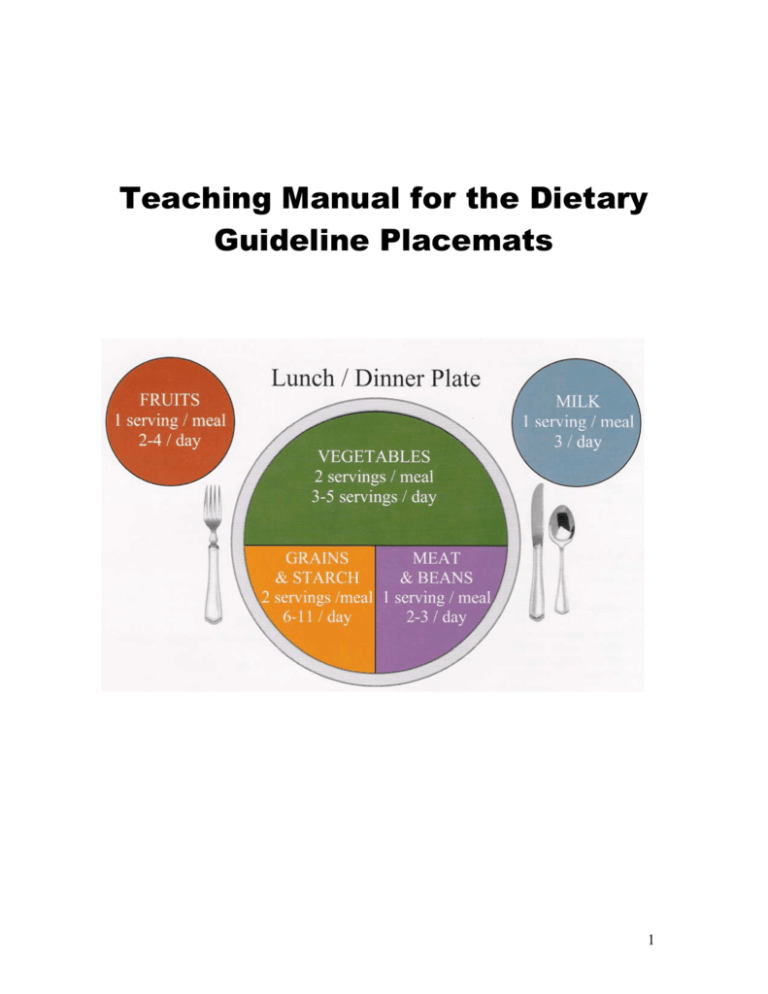
Teaching Manual for the Dietary Guideline Placemats 1 Lesson #1: The Placemat Description: This lesson will provide an overview of the purpose and message behind the placemats. Things to bring to the lesson: • The Nutritional Placemat Objectives: At the end of this lesson, each participant should be able to understand…. • Why eating a healthy diet is important. • How the placemat helps them eat a healthy diet. • How many calories are needed each day. • What supplements are recommended and why. • How much fiber they should eat and where to find it. • How much water they should drink. • What fats and oils are best. • What spreads they should use. Ideas for the Instructor: Pass out the placemats. Then, ask the questions below, and have the seniors respond using their knowledge and the information found on the placemats. Use the information below each question to help you discuss each topic. Important points are in bold. Why is eating a healthy diet important? A good balanced diet can help you live longer and have a better quality of life. A good diet can decrease your chances of getting chronic diseases such as diabetes, high blood pressure, osteoporosis (weak bones), heart disease, and certain cancers. Also, a good diet is linked to a decrease in the severity of many of diseases just mentioned. Finally, a balanced diet might decrease your healthcare costs and your risk of depression. How does the placemat help you eat a healthy diet? The placemat displays many of the US government’s dietary recommendations in a simplified and visual manner. The major emphasis of the placemat and the dietary recommendations is to help you to increase the amount and variety of fruits, vegetables, whole-grains, and low/fat-free milk products that you consume. Most Americans do not eat enough of these foods, but instead they eat too much saturated fats, trans-fats, cholesterol, added sugars, and salt. The placemat can be placed on your table and serve as a frequent reminder of what you should be eating. It includes examples of each food group along with what is considered a serving size. Also, the placemat includes information on fiber intake, oil intake, recommended supplements, suggested daily Calorie intake, and water intake. 2 How many calories do you need each day? The amount of calories needed each day depends on a number of things including how much you weigh and whether you are trying to lose, gain, or maintain your weight. The placemat (on the breakfast side) contains a quick method to get a rough estimate of how many calories you need to consume each day. First, decide if you need to lose, gain, or maintain your weight. Then, find the calories per pound on the placemat and multiply it by your weight. (See example on the placemat.) The suggestions are only estimates and if you find your weight is not going in the direction you desire, make changes accordingly. It is well known that many Americans consume more calories than they need, resulting in increased levels of obesity, diabetes, and heart disease. Yet, despite having diets high in calories, most Americans still do not eat the recommended amounts of nutrients. To avoid excess calories and still eat the recommended servings, it is important to eat a variety of nutrient-dense foods (like fruits and vegetables), while avoiding foods high in saturated and trans-fats, cholesterol, added sugars, and salt. What supplements are recommended and why? Calcium supplements are important to keep bones strong and decrease your risk of osteoporosis and hip fractures. Calcium can also be obtained from milk products and in various non-dairy foods such as fortified cereals, spinach, rainbow trout, and collards. The daily recommended dose of calcium is 1200 mg. 1 cup of milk contains only 300 mg, so even if you eat the recommended 3 servings of milk, you may need to take a calcium supplement. Vitamin D supplements are a recommended for seniors. Vitamin D is necessary for calcium absorption, and calcium is needed to keep bones strong. As we age we are not able to synthesize vitamin D from the sun. Therefore, seniors should take Vitamin D supplements each day. The daily recommended dose for those over 70 is 600 IU. Milk also contains Vitamin D, but 1 cup of milk only contains 100 IU of Vitamin D. Vitamin B12 supplementation is often recommended to seniors, since individuals over age 50 cannot absorb naturally occurring B12 as well as when they were younger. Obtaining enough B12 is import to help decrease your risk of having low red blood cell counts (anemia) or having problems with your nervous system. How much fiber should you eat and where can you find it? High fiber diets decrease the risk of coronary artery disease, colon cancer, diverticulosis (bowel outpouchings), and constipation. The recommended amount of fiber is 14 grams per 1,000 calories per day or roughly 30 grams per day for men and 21 grams per day for women. Fiber can be found in whole grains (breads, cereals, pasta, rice, etc.), legumes (dry beans, peas), vegetables, and whole fruits. Try to substitute at least half of your refined grain products for whole grain products. Legumes are nutrient rich, and part of both the vegetable and the meat & bean food groups. Whole fruits, whether fresh, frozen, canned, or dried, are preferred over fruit juices since they contain more fiber. 3 How much water should you drink each day? Eight cups of fluids per day are recommended. Eight cups equals 4 tall glasses of fluids. However, all fluids, including water, juice, milk, soup, and non-caffeinated drinks count towards the total recommended daily amount of fluids. However, water contains no calories, and thus is preferred. In most cases, the combination of thirst and normal drinking behaviors such as drinking with meals is enough to prevent dehydration. However, if you will be exposed to heat stresses or vigorous exercise, purposeful drinking is suggested. What fats and oils are best? A healthy diet includes fats and oils; however, the types and amounts of fats and oils are important considerations. Too much fat in your diet can lead to eating too many calories. However, too little fat in your diet could lead to not getting enough vitamin E or essential fatty acids. This is rarely a problem, since most Americans eat too much fat. Keep your total fat intake to between 20-35% of your total calories. Not all fats are equal. Diets high in saturated fats, trans-fats, and cholesterol can increase unhealthy blood lipid levels, which can lead to heart disease. Therefore, most fats you consume should be polyunsaturated and monounsaturated fats. Nuts and plant oils (like canola and corn oil) that are liquid at room temperature are rich in healthy monounsaturated fats. However, palm and coconut oils should be avoided, since they are full of saturated fats as shown by them being solid at room temperature. Other solid fats like lard, meat fat, and shortening should be avoided, because they contain a lot of saturated fat. What spreads should you use? Choose soft tub margarine for spreading on bread, since it has the least amounts of saturated fats and calories. Also, many tub margarines nowadays have no trans-fats, which is the worst type of fat because it raises bad cholesterol (LDL) and lower good cholesterol (HDL). Saturated fats also raise bad cholesterol (LDL), but they do not affect good cholesterol (HDL). Nevertheless, both should be avoided since both increase your risk of heart disease. Stick margarine should be avoided and butter should be used sparingly. Both contain much more saturated fat and trans-fat than tub margarine. Both contain about the same amount of total fat. However, stick margarine contains much more trans-fat, which is the least healthy type of fat. 4 Lesson #2: Portion Sizes Description: This lesson is designed to help seniors understand and visualize what a serving size looks like. Things to bring to the lesson: • The Nutritional Placemat • Typical cereal bowl • A regular sized dinner plate (about 9 inches in diameter) • A tall drinking glass • A 1 cup measuring cup • A ½ cup measuring cup • A measuring cup for liquids with cups and fluid ounces marked on the sides • A box or bag of cereal • Bottle of water • A standard sized deck of playing cards (about 3 ½ x 2 ½ x ¾ inches) Objectives: At the end of this lesson, each participant should be able to understand…. • How many servings of each food group they should you eat. • What a serving size is. • What a serving size looks like. Ideas for the Instructor: Pass out the placemats. Then, ask the questions below, and have the seniors respond using their knowledge and the information found on the placemats. Use the information below each question to help you discuss each topic. Important points are in bold. How many servings of each food group should you eat? The simple answer is that you should eat 2-4 servings per day of fruit, 3-5 servings per day of vegetables, 6-11 servings per day of grains & starch, 2-3 servings per day of protein (meat & beans), and 3 servings per day of milk. This can be difficult to remember. The placemat takes the daily recommended servings, divides them among the three main meals of the day, and displays the servings in a graphical representation of a meal put out on a table. For example, on the Breakfast Placemat, you see a representation of a regular sized plate and a cup of milk. The cup of milk represents 1 serving. Also, each quarter of the plate represents 1 serving, except for the grains, whose quarter represents 2 servings. Having two servings of grains represented by only one quarter of the plate was done, so that grains, which most Americans eat enough of, were deemphasized, while simultaneously emphasizing fruits and vegetable, which Americans do not eat enough of. Therefore, for breakfast you should have 1 serving of fruit, 1 serving of vegetables, 1 5 serving of protein (meat & beans group), 1 serving of milk, and 2 servings of grains. If you are successfully following the placemat, your actual breakfast plate might often resemble the placemat itself. On the Lunch & Dinner Place Mat, you see a dinner plate, a cup of fruit, and a cup of milk. Again, each cup represents 1 serving, and each quarter represents 1 serving, except for the grains. Therefore, for both lunch and dinner you should eat 1 serving of fruit, 1 of milk, 2 of vegetables, 1 of protein (meat & beans group), and 2 of grains. You will notice that 2 servings of vegetables equal two quarters or 1 half of the plate. This is to again emphasize the need for increased vegetables in your diet. How big is a serving size? The size of a serving varies depending on what the food item is. For fruit, one serving is often ½ cup fruit, a medium sized apple, ½ cup of juice, or ¼ cup dried fruit. For vegetables, one serving is often ½ cup cooked or 1 cup raw. For grains, one serving is often 1 ounce or 1 slice of bread, 1 cup dry cereal, or ½ cup cooked rice, pasta, or cereal. For the meat or protein group, one serving is 3 ounces of cooked meat or ½ cup of cooked beans. (Remember, there are 16 ounces in a pound, so one serving is 3/16th of a pound.) For milk, one serving of milk is 1 cup milk (1 cup = 8 fluid ounces or about half of a tall glass), 2 cups cottage cheese, or 2 ounces of hard cheese. What does a serving size look like? Ideas for the instructor: Use the props listed at the top of the lesson to help everyone visualize what a serving looks like. General serving sizes: • 1 cup of liquid (8 fluid ounces): The common size of 1 serving of milk, 2 servings of fruit juice, or of water. Pour 1 cup (8 fluid ounces) of water into a tall glass and demonstrate that it only halfway fills a tall glass. A tall glass is about 2 cups (2 milk servings, 4 fruit servings, or 2 cups of water). • 1 cup of solids: The common size of 1 serving of dry cereal or 1 serving of raw leafy vegetables. Measure 1 cup of cereal and pour it into a cereal bowel to show the class what it looks like. 1 cup of solids is also about the size of a baseball. • ½ cup of solids: The common size of 1 serving of cooked cereal, pasta, or rice; 1 serving of cut fruit, or 1 serving of beans. Measure ½ cup of cereal and pour it into a cereal bowel to show the class what it looks like. ½ cup is also about the size of half of a baseball. • ¼ cup of solids: The size of 1 serving of dried fruit. It is about the size of a golf ball. 6 Meat Serving Size: 1 serving of protein is a piece of meat that has been cooked down to 3 ounces. 3 ounces of meat is about the size of deck of card. Notice that a deck of cards covers about a quarter of the plate and NOT half of the plate. Bread Serving Size: 1 serving is equal to 1 slice of bread, ½ cup cooked cereal, or 1 cup of dry cereal. 7 Lesson #3: Food Choices Description: This lesson is designed to help seniors know what foods they can chose from in order to create the balanced meals suggested by the placemat. Things to bring to the lesson: • The Nutritional Placemat • The Daily Nutrition Menu for Adults Objectives: At the end of this lesson, each participant should be able to understand…. • What some examples of a balanced breakfast, lunch, or dinner are. • How to eat more vegetables. • How to eat fruits and vegetables less expensively. • How to eat enough fiber. • Whether eggs are recommended or not. Ideas for the Instructor: Pass out the placemats and the daily nutrition menus. Then, ask the questions below, and have the seniors respond using their knowledge and the information found on the placemats and the menus. Use the information below each question to help you discuss each topic. Important points are in bold. What are some examples of a balanced breakfast, lunch, or dinner? Have the seniors use the placemat and/or menu to come up with balanced meals. Breakfast should have about 1 serving of fruit, 1 serving of vegetable, 1 serving of milk, 1 serving of protein (meat & beans group), and 2 servings of grains. Lunch and dinner should have about 1 serving of fruit, 2 servings of vegetable, 1 serving of milk, 1 serving of protein (meat & beans group), and 2 servings of grains. How can you eat more vegetables? Eat vegetables like carrots, celery, and cucumbers for snacks. Choose side-salads instead of French fries. Add vegetables to soups, stews, casseroles, and stir-fries. Prepare main dishes, side dishes, and salads with vegetables and beans. Try to eat a wide variety of vegetables. Most Americans need to eat more dark-green and orange vegetables, and dry beans and peas. However, many Americans need to watch or cut-down on the amount of starchy vegetables they eat. Starchy vegetables like white potatoes, corn, and green peas contain many calories. To avoid eating too many calories, try selecting small portions of potatoes and French-fries. 8 How do you reduce the cost of fruits and vegetables? Buy fruits and vegetables that are in season. They are usually much cheaper. Though fresh food is ideal, dried, canned, and frozen foods also count as food group servings. With frozen vegetables, it is easy to heat single servings in the microwave without worrying about losing the rest to rot. If you choose canned fruit, fruit canned in juice or water is better than fruit canned in light or heavy syrup because syrups contain added sugar. How can you eat enough fiber? Eat a majority of your fruit group servings as whole or dried fruit, instead of juice. Juice has less fiber. Eat legumes (dry beans and peas) several times per week, since they are very rich in fiber. Legumes count in both the meat and vegetable groups. Make at least half of your total grains eaten whole grains. This can be done by buying whole grain breads, cereals, pastas, and rice. Should you eat eggs? Yes, you may eat eggs. Eggs are an important source of protein. It is currently recommended to eat 7 eggs per week. However, there is something you need to keep in mind. One egg yolk contains two-thirds the daily recommended amount of cholesterol. Therefore, if you eat more than 1 egg per day, you will surpass the daily recommended amount of cholesterol. 9
